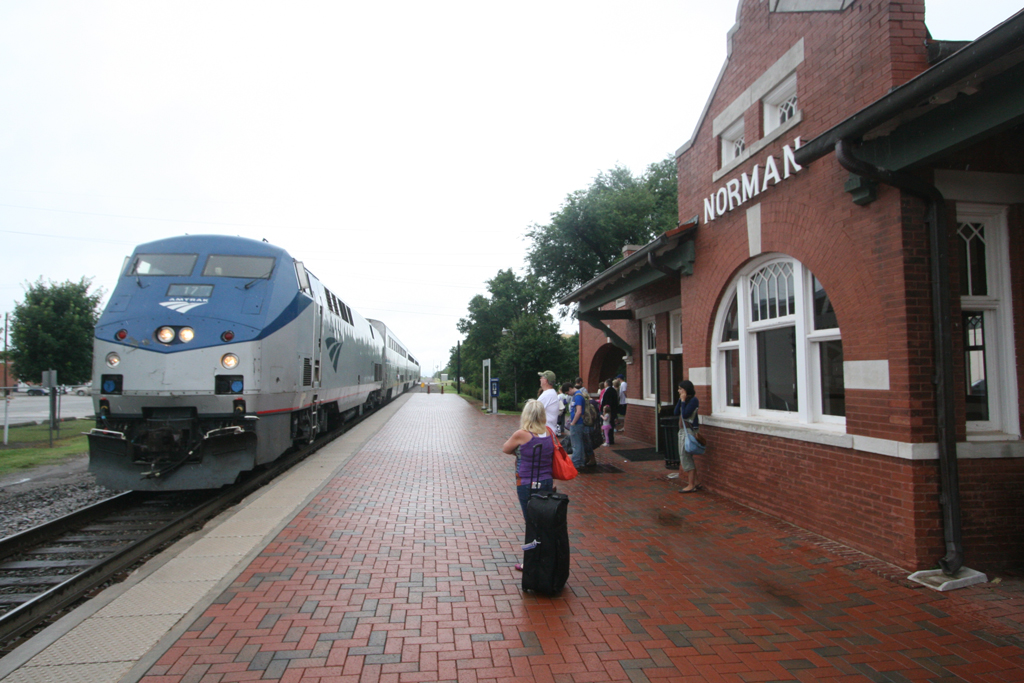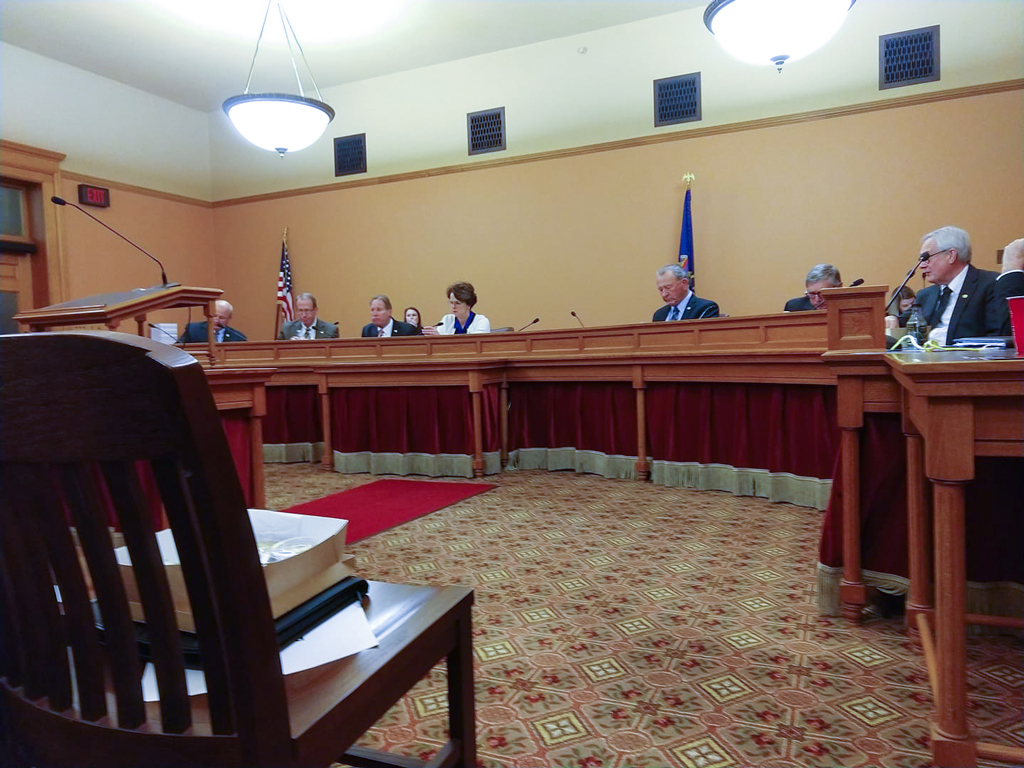TOPEKA, Kan. — The Ways and Means Committee of the Kansas State Legislature met Jan. 22 to hear testimony from Amtrak, BNSF Railway, and others about extending the route of Amtrak’s Heartland Flyer from Oklahoma City, Okla., to Newton, Kan., where it would provide a connection with Amtrak’s Southwest Chief. The current route runs from Fort Worth, Texas, to Oklahoma City.
Amtrak spokesman Ray Lang provided an overview of how Amtrak works with states on regional trains. There are 17 states that pay Amtrak to run trains and it is the fastest growing part of the company. Lang says 50% of Amtrak’s ridership is on a train that is state funded. “It’s been awhile since we’ve added a state partner,” Lang says. “The reason for that is because the cost barriers to running short intercity passenger trains is extremely high. We tend to find that they are higher than a state can afford. BNSF is working with us and [Kansas Department of Transportation] to find out what it would cost to put an Amtrak train on the railroad.”
The joint BNSF and Amtrak study won’t be ready to present until the end of January, but Lang estimates that it will be millions of dollars and probably beyond what the states would be willing or able to pay. Amtrak is proposing in its reauthorization a robustly funded federal grant program to help states pay for upfront capital costs associated with the start of new passenger trains. In addition to paying for 100% of upfront capital costs, grant money would also be available to cover operating expenses for the first few years. “The Heartland Flyer corridor is certainly one of the places that we think would be a perfect place to invest capital money from this billion-dollar grant program,” Lang says.
The transportation department’s Deputy Secretary Lindsey Douglas says there is a path forward once they know the capital investment required and offered to prepare a summary sheet of the costs for all interested parties once the study is presented. “The new federal grant program would open up a lot of doors to get this project funded,” Douglas says.
Before adjourning, Kansas Sen. Carolyn McGinn, chairwoman of the Ways and Means Committee, asked Lang about Amtrak CEO Richard Anderson’s recent proposals that would truncate the Southwest Chief route through portions of Kansas, Colorado, and New Mexico, and substitute buses for train service. “We’re very proud of the long-distance trains,” says Lang. “The growth opportunities are in short-distance regional trains, which is why we’d love to extend the Heartland Flyer north of Oklahoma City to Wichita, Kan., and connect with the Southwest Chief in Newton.”
















A lot of talk and I’m all for the extension of the Heartland Flyer, but when I take an occasional air trip I see terminals that are continually being remodeled.
I rode the passenger trains of the sixties and those days are gone. The best we get nowadays is the revival of commuter trains.
BRADEN – What you propose in your post below is the minimum service level that makes any sense. I can assure you it will never happen. Making sense has nothing to do with anything.
In reference to below.. Make the SWC a 3 section train out of CUS. Have the second section split at Newton and continue on to Fort Worth. At FW have the two remaining sections split for their prospective terminating points of San Antonio, and Houston. 3 round trips daily if you want it to be a viable service..
And this coming the same day that the Amtrak ticket office in Newton – the last staffed station in Kansas – was closed by Amtrak! Jim Wrinn & Company, if you haven’t heard that news let, it is on the Friends of the Southwest Chief Facebook page …
I would suggest that the Chief leave Chicago in 5 sections if the platforms were long enough, which they are not.
Section 1: Chicago-Houston. Run it via Dallas. The southbound Chief should meet the southbound Eagle between Ft Worth and Dallas. Eagle passengers to/from Houston transfer at Dallas. Chief passengers to/from San Antonio transfer at Ft Worth.
Section 2. Chicago-Denver. Yes, I know that the Zephyr provides a more direct service, but not from Kansas City or St. Louis. Reroute the Chief through Pueblo to avoid maintaining La Junta-Trinidad.
Section 3. Chicago-Phoenix.
Section 4. Chicago-Las Vegas (split at Barstow).
Section 5. Chicago-LA.
This would allow other sections, not on the train when it leaves Chicago, including:
Houston-Denver
Denver-Phoenix
Denver-Las Vegas
Denver-LA
Would this require a lot more subsidy than the Chief requires today? Maybe not. Each section would serve multiple markets so the trains would be longer and probably carry a lot more passengers. It would, however, require a lot of capital to make it happen, for rolling stock, longer platforms, and ROW improvements the RRs would require.
I know I am just dreaming.
Southern Montana has looked at the old Hiawatha line and as Amtrak states it is 1.5 Billion dollars to add this to their system it will never happen.Just think if we had that trillion Trump and his cronies gave to the billionaires maybe we could afford to do something for the regular folks.Just dreaming!!
Preliminary results for FY2019 include operating revenue of $3.3 billion, a 3.6% increase over FY2018; an operating loss of $29.8 million, a $140.9 million, or 82.6% improvement from FY2018.
Now if you want to believe those stats, it seems Amtrak forgot to mention the $1.9 Billion Federal subsidy in their math. So Amtrak thinks they can break even in FY2020, but that would only mean they are still $1.9B in the hole.
The ‘Heartland Flyer’ and its proposed extension to Newton, Kansas are on the former route of the Houston – Chicago ‘Texas Chief’. Extending the “Heartland Flyer south from Fort Worth to Houston and north to Newton and then east as a separate train to Chicago would undo some of the 1979 cutbacks on Amtrak’s long distance trains.
The ‘Heartland Flyer’ can be renamed the ‘Texas Chief’ which has historic value. Sleeping, dining and lounge cars would be added to the coach-only consist of the existing train.
The original ‘Texas Chief’ did take a circuitous route between Houston and Fort Worth when Santa Fe and Burlington Northern were separate railways. With the restoration of service, the ‘Texas Chief’ can run a direct course over the former route of the ‘Sam Houston Zephyr’ on what was the Burlington-Rock Island Railroad. Dallas would get a second intercity passenger train in the process as well as Houston.
Why in the world would Kansas want to fund a train that would serve the state only during the night and require a middle of the night transfer in Newton. Amtrak should fund it and make it a Chicago-OKC section of the Chief. A Denver-La Junta-Newton OKC section would be good too I don’t know if either are over 750 miles, but it may not require much subsidy as they would be entering 2 new significant markets with minimal additional train-miles.
If Kansas were to fund something, I would suggest a KC-Topeka-Wichita day train. Maybe Oklahoma could fund a daytime extension to OKC. This could be an extension of the current STL-KC service.
Why in the world would Kansas want to fund a train that would serve the state only during the night and require a middle of the night transfer in Newton. Amtrak should fund it and make it a
One of my great memories in this life was riding Amtrak’s Super Chief El Capitan WB through Kansas City in January 1972, at a time when Amtrak trains were run with 100% ATSF equipment, crews and commissary. The only thing that had changed was running out of Chicago Union Station. At Kansas City, an ATSF “warbonnet” F pulled in one of the opposing trains. Leaving KCMO, the second opposing train. I don’t know which EB was the Texas Chief and which was the Super, doesn’t matter. The point is, there were two trains each direction on the route.
Now what’s proposed is a connecting train. Read the news, Amtrak. What’s proposed isn’t as good as what we used to have.
So this is what it’s come down to: a third-rate system (even compared to Amtrak’s earlier decades) and even then only if a successful shakedown of the states and the cities. For all this shaking down we can’t get anything close to what we had late in the ATSF era and early in the Amtrak era.
Plus all the waste and redundancy in the military could do that plus improve the lives and health of all American’s…but yes, only a dream.